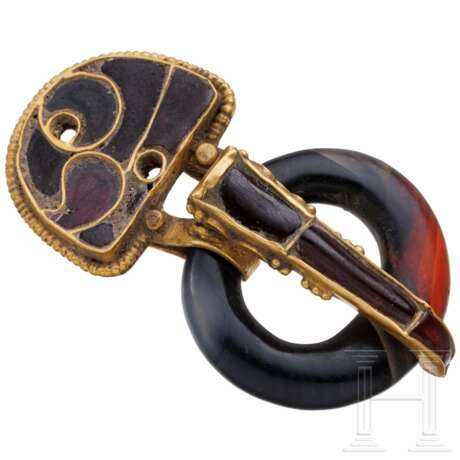Schnalle aus Gold mit Einlagen aus Halbedelsteinen, ostgermanisch, 1. Hälfte 5. Jhdt. n. Chr.
19.11.2024 10:00UTC +01:00
Classic
Starting price
1800EUR € 1 800
| Auctioneer | Hermann Historica |
|---|---|
| Event location | Germany, Grasbrunn / München |
| Buyer Premium | 25 % |
Archive
The auction is completed. No bids can be placed anymore.

ID 1323362
Lot 4151 | Schnalle aus Gold mit Einlagen aus Halbedelsteinen, ostgermanisch, 1. Hälfte 5. Jhdt. n. Chr.
Prunkvolle Gürtel- oder Schuhschnalle, typisch für die romano-barbarische Mischkultur im mittleren und unteren Donauraum in den Randgebieten des spätrömischen Reiches und der davor liegenden Peripherie. Halbkreisförmige Grundplatte des Schnallenbeschlags. Darauf Zellwerk mit ca. 3 mm hohen Zargen, die ein asymmetrisches Zellwerk mit geschwungenen Zellwänden bilden. Die Zellen mit flachen, zurecht geschliffenen Granaten gefüllt. Außen umgeben von Kerbdraht.
In der Mitte zwei runde Röhrchen für die Aufnahme von (nicht erhaltenen) Nieten zur Befestigung am Lederriemen. An der vorderen Kante zwei Laschen mit zwei Nieten befestigt, die einen rundstabigen, annähernd kreisförmigen Bügel aus Achat umschließen, der sich nach vorne hin verdickt. Zwischen den Laschen der Schnallendorn mit einem von der hinteren Basis ausgehenden Haken befestigt, der den Bügel aus Achat hinten umschließt. Auf der Oberseite drei Zellen mit rechteckigen, oben gewölbten Granateinlagen. Die Seiten des Schnallendorns in der hinteren Hälfte mit von Granalien flankierten S-Spiralen aus Golddraht verziert.
Drei nicht passgenaue kleinere Einlagen in der oberen Hälfte des Zellwerks vom Beschlag wohl nach Verlust der originalen Einlagen nachträglich ergänzt. Länge 4,9 cm. Gewicht 19,29 g. Minimale Inkrustationen auf der Oberfläche. Abgesehen von den wahrscheinlich ergänzten Einlagen ausgezeichnet erhalten.
Provenienz: Rheinischer Privatbesitz, zuvor in den 90er Jahren Sammlung R.Z. München.
An East Germanic buckle made of gold with inlays of semi-precious stones, 1st half of the 5th century A.D.
An East Germanic buckle made of gold with inlays of semi-precious stones, 1st half of the 5th century A.D.
Magnificent belt or shoe buckle, typical of the Romano-Barbarian mixed culture in the middle and lower Danube region on the fringes of the late Roman Empire and the periphery before it. Semi-circular base plate of the buckle fitting. On top of this, cloisonné work with approx. 3 mm high frames forming an asymmetrical cloisonné with curved cell walls. The cells filled with flat, polished garnets. Surrounded on the outside by notched wire.
Two round tubes in the centre for holding rivets (not preserved) for attachment to the leather strap. Two sheet straps attached with two rivets to the front edge, enclosing a round, almost circular frame made of agate, which thickens towards the front. The buckle prong is attached between the straps with a hook extending from the prong's base and enclosing the agate frame at the back. Three cells on the top with rectangular garnet inlays curved at the top. The sides of the rear half of the prong are decorated with gold wire S-spirals flanked by garnets.
Three smaller, inaccurate inlays in the upper half of the barrel probably added later after the loss of the original inlays. Length 4.9 cm. Weight 19.29 g. Minimal incrustations on the surface. Apart from the probably replaced inlays, in excellent condition.
Provenance: Rheinischer Privatbesitz, zuvor in den 90er Jahren Sammlung R.Z. München.
Condition: II +
| Auction house category: | Migration period and early middle ages |
|---|
| Auction house category: | Migration period and early middle ages |
|---|
| Address of auction |
Hermann Historica Bretonischer Ring 3 85630 Grasbrunn / München Germany | ||||||||||||||
|---|---|---|---|---|---|---|---|---|---|---|---|---|---|---|---|
| Preview | |||||||||||||||
| Phone | +49 (0)89 5472 649 0 | ||||||||||||||
| Fax | +49 (0)89 5472 64999 | ||||||||||||||
| Buyer Premium | 25 % | ||||||||||||||
| Conditions of purchase | Conditions of purchase | ||||||||||||||
| Business hours | Business hours
|


